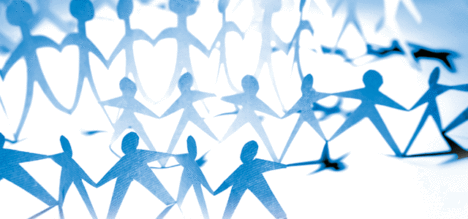It’s about guilt
October 1, 2020

Mainstream culture has tried to airbrush guilt out of everyday life. It’s the ultimate social faux pas, it seems, to make someone feel guilty—How dare you judge me! Or maybe it’s the penultimate faux pas, because what’s even worse than making someone feel guilty inside is to shame them in front of others. The list of twenty-first century sins includes body-shaming and mother-shaming. Sin. Now there’s another word you’d be wise to avoid in our current cultural climate.
Because if you don’t, you may quickly discover that judgement, guilt and shame are alive and kicking. In some circles, the subtlest of “microaggressions” or deviations from the current politically correct line on race, gender or whatever will provoke a pile-on as a horde of finger-pointing social media critics call for your de-platforming, disinviting, sacking and exile into outer darkness.
An anxious generation
As the millennial generation came of age and entered the workforce during the past decade or so, there was much eye-rolling at their perceived lack of work ethic and level of entitlement; their “snowflake” status that demanded kid gloves and special arrangements. Still, somehow, despite being raised to have confidence and a healthy self-esteem—free of the guilt-inducing parenting of previous generations—“Millennials experience extremely high levels of anxiety and perfectionism,” according to The Atlantic in a recent feature titled, “Why suicide rates among Millennials are rising.”
“They have almost double the rate of anxiety disorders compared to Baby Boomers,” says Nadine Kaslow, a psychiatrist quoted in the article, which reports that shame “is one of the bigger drivers of suicide”.
Suicide is Australia’s leading killer of adults aged 15–44. In older people it’s the fourth leading cause of death—right up there with heart disease, cancer and diabetes. In the US, suicide rates have been gradually creeping up; an increase of 40 per cent over the past 18 years. Experts are sounding the alarm, alerting both health professionals and the general public to the warning signs a person may show if they’re at risk of suicide.
“Are they showing that they have intense shame or guilt about something?” is one question suicide-prevention La Trobe University researchers Carina Chan and Karien Hill say we should ask, as reported in The Canberra Times. And a series of high-profile cases illustrates the truth of this. Former South Korean president Roh Moo-Hyun died in 2009 by his own hand after an investigation into corrupt behaviour became public. Then there was last year’s suicide in custody of Jeffrey Epstein, whose serial abuse of underage girls allegedly extended to procuring victims for a number of high-profile men involved in business, politics and public life.
What most of us will find more tragic, however, is the shame experienced by the victims themselves. The case of 15-year-old Audrie Pott, for example, who died by suicide after students at her Saratoga, California, school widely shared images of her naked body, scribbled on with permanent markers as she lay drunk and passed out at a house party. “My life is over. . . . I ruined my life and I don’t even remember how,” Audrie wrote to a friend in a Facebook message, later recounted by Rolling Stone.

Dealing with guilt
While the Western world has generally moved towards more openness and acceptance, could it be that we’ve messed up when it comes to guilt? While our lifestyles have been liberated, it seems our consciences have not. Despite our proud self-reliance, it turns out we are social beings after all—we do care what other people think. And we want to be able to look at ourselves in the bathroom mirror at 3am without flinching.
“What a wretched man I am! Who will rescue me from this body that is subject to death?” agonised the apostle Paul (Romans 7:24). Like many of us, he felt he was being torn apart by the battle raging within his soul: “although I want to do good, evil is right there with me” (verse 21).
The ancients in biblical lands dealt with their guilt and shame in various ways—the appeasement of angry gods was popular via punishment of the body or extravagant gifts, including the ritual slaughter of animals, or even humans.
The God of the Hebrews likewise asked for animal sacrifices, usually involving the slaughter, dismemberment and cooking or burning of domestic animals ranging from doves to oxen. The earliest books of the Bible, in particular Exodus and Leviticus, set out in detail the various sacrifices required in connection with various events and festivals, including “guilt offerings” and “sin offerings”. The prophet of the Exodus, Moses, conveyed God’s instructions as to how this should all happen, including the construction of the desert tent-temple where the sacrifices would occur; a structure often referred to as the tabernacle or sanctuary, which consisted of the “tent of meeting” surrounded by a courtyard.
But the purpose of the rituals and structure, from God’s point of view, was not about appeasement. “Then let them make a sanctuary for me, and I will dwell among them,” He said in Exodus 25:8. God wanted to find a way to be close to His people.
He also wanted to teach them two things:
≈ Firstly, that sin is a big deal. Breaking God’s law has consequences and the ultimate consequence of rejecting the Source of Life is death. The slaughter and blood of each sacrificial animal reinforced this message.
≈ Secondly, that God was providing a solution for the problem of sin. When a person brought to the tabernacle one of their perfect, unblemished animals, laid their hands on it to symbolically transfer their guilt and then killed it by those same hands, they saw that innocent victim die in their place. During these centuries of sacrifice, God was preparing the people of Israel to fully and deeply hear the proclamation spoken when Jesus appeared on the scene: “Look, the Lamb of God, who takes away the sin of the world!” (John 1:29).
A greater tabernacle
The Bible indicates in a number of places that the sanctuary services were not just God’s teaching tool here on earth, they also echoed a higher and deeper reality in heavenly places. The New Testament book of Hebrews, in particular, explores this theme: “But when Christ came as high priest . . . he went through the greater and more perfect tabernacle that is not made with human hands, that is to say, is not a part of this creation. He did not enter by means of the blood of goats and calves; but he entered the Most Holy Place once for all by his own blood, so obtaining eternal redemption” (9:11, 12).
These two verses are packed with meaning. They tell us that Jesus is, in some very real heavenly sense, a high priest; “a great high priest who has ascended into heaven” (4:14). They tell us that His blood—that is, His death on the cross—has the power to save “once for all” (10:10); much greater power than the repeated animal sacrifices of the earthly sanctuary. And they tell us that there is a “greater and more perfect tabernacle” that exists outside the human realm.
The apostle John actually caught a glimpse of this heavenly tabernacle in the visions he recorded in the book of Revelation: “Then God’s temple in heaven was opened, and within his temple was seen the ark of his covenant” (11:19).
But, later in Revelation, when John sees a vision of the far future—the New Jerusalem, a massive glittering cubed city measuring more than 2250 kilometres in each dimension, descending to an earth now cleansed of evil and death—he notices that there is no temple in the city (21:22). Why? Because sin has been dealt with. The Lamb has been sacrificed, the way directly into God’s presence has been opened, the High Priest’s work is complete.
But God’s passion for His people remains the same as it was back in the desert: “Look! God’s dwelling-place [tabernacle, KJV] is now among the people, and he will dwell with them. They will be his people, and God himself will be with them and be their God” (21:3). All this time, that’s what He’s been wanting—to sweep aside the curtain of sin and separation and see us face to face.
Detox from guilt
Do you struggle with guilt? Maybe it’s a healthy reaction because you’ve genuinely messed up, hurt others and hurt yourself. Maybe it’s a toxic shame that’s threatening to drag you down and strangle your hope. Right now, on this earth, encounters with guilt, shame and failure are a part of being human. But right now, in heaven, Jesus our great High Priest is ready to take even our darkest, deepest guilt and offer forgiveness and peace in its place, on the strength of His “once for all” sacrifice.
Yes, sometimes it feels like every day is a struggle. But, with Jesus, every day is a new start. He’s not asking for a sheep or a goat, or even a cash payment. He just wants you.
If you or someone you know is struggling with suicidal feelings, don’t hesitate to reach out to a mature trusted friend, a healthcare professional or an online/phone service such as Lifeline (Australia—
13 11 14; New Zealand—0800 543 354).
Kent Kingston is editor of Signs of the Times. He lives with his family in NSW’s Lake Macquarie region, north of Sydney.









